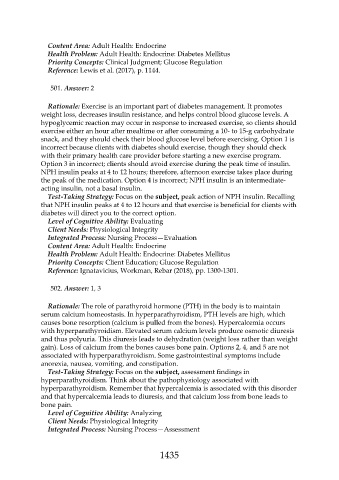Page 1435 - Saunders Comprehensive Review For NCLEX-RN
P. 1435
Content Area: Adult Health: Endocrine
Health Problem: Adult Health: Endocrine: Diabetes Mellitus
Priority Concepts: Clinical Judgment; Glucose Regulation
Reference: Lewis et al. (2017), p. 1144.
501. Answer: 2
Rationale: Exercise is an important part of diabetes management. It promotes
weight loss, decreases insulin resistance, and helps control blood glucose levels. A
hypoglycemic reaction may occur in response to increased exercise, so clients should
exercise either an hour after mealtime or after consuming a 10- to 15-g carbohydrate
snack, and they should check their blood glucose level before exercising. Option 1 is
incorrect because clients with diabetes should exercise, though they should check
with their primary health care provider before starting a new exercise program.
Option 3 in incorrect; clients should avoid exercise during the peak time of insulin.
NPH insulin peaks at 4 to 12 hours; therefore, afternoon exercise takes place during
the peak of the medication. Option 4 is incorrect; NPH insulin is an intermediate-
acting insulin, not a basal insulin.
Test-Taking Strategy: Focus on the subject, peak action of NPH insulin. Recalling
that NPH insulin peaks at 4 to 12 hours and that exercise is beneficial for clients with
diabetes will direct you to the correct option.
Level of Cognitive Ability: Evaluating
Client Needs: Physiological Integrity
Integrated Process: Nursing Process—Evaluation
Content Area: Adult Health: Endocrine
Health Problem: Adult Health: Endocrine: Diabetes Mellitus
Priority Concepts: Client Education; Glucose Regulation
Reference: Ignatavicius, Workman, Rebar (2018), pp. 1300-1301.
502. Answer: 1, 3
Rationale: The role of parathyroid hormone (PTH) in the body is to maintain
serum calcium homeostasis. In hyperparathyroidism, PTH levels are high, which
causes bone resorption (calcium is pulled from the bones). Hypercalcemia occurs
with hyperparathyroidism. Elevated serum calcium levels produce osmotic diuresis
and thus polyuria. This diuresis leads to dehydration (weight loss rather than weight
gain). Loss of calcium from the bones causes bone pain. Options 2, 4, and 5 are not
associated with hyperparathyroidism. Some gastrointestinal symptoms include
anorexia, nausea, vomiting, and constipation.
Test-Taking Strategy: Focus on the subject, assessment findings in
hyperparathyroidism. Think about the pathophysiology associated with
hyperparathyroidism. Remember that hypercalcemia is associated with this disorder
and that hypercalcemia leads to diuresis, and that calcium loss from bone leads to
bone pain.
Level of Cognitive Ability: Analyzing
Client Needs: Physiological Integrity
Integrated Process: Nursing Process—Assessment
1435

